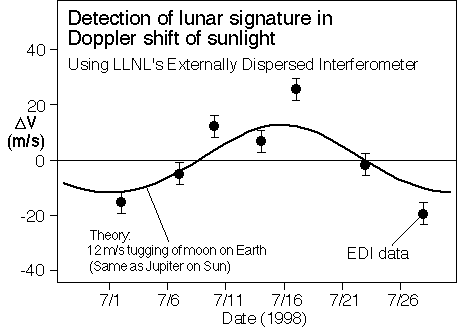First Demonstration of Doppler Velocimetry using an Externally Dispersed Interferometer
The first EDI apparatus demonstrated Doppler velocimetry by observing sunlight over 1 months time. The solar fringe shift was compared to an absolute wavelength reference provided by an iodine cell. After subtracting away the effect of the rotation of the Earth, we detected in the solar velocity the 12 m/s amplitude effect of the pull of the Moon on the Earth. This also demonstrates that velocity drifts over 1 month time were not more than 8 m/s, and probably less than that. We believe that the 8 m/s scatter in the data is mostly due to a known dependence of the roof-top heliostat on pointing angle, acting on the 4000 m/s velocity gradient across the solar disk. The portion of error from the EDI itself, apart from the heliostat, was estimated at 4 m/s, based on the bromine repeatibility tests (below). For more info see Ref. 1 & 4
A bromine cell backlit by white light was used to simulate a stellar spectrum in repeatibility tests. This avoided any heliostat pointing error, and avoided the several m/s amplitude natural oscillation in the solar photosphere. The EDI was able to achieve ~1 m/s instrument limited precision of 18 minutes, and ~4 m/s over many days. This is remarkable, since no environmental controls or cavity stabilization was used as would be expected in a mature installation. The EDI apparatus is pictured below. Ref. 1 & 3
Photograph of an EDI using a small Michelson interferometer having 1 cm delay, in series with a commercial linear grating spectrograph of R~20,000 resolution. A relay lens images light from end of fiber to mirror plane of interferometer, where fringes are imposed. Another lens images mirror plane to slit of spectrograph. |
||
 |
||
Closeup of the angle-independent fixed delay interferometer. A 1/4 inch thick glass plate (in 1" diameter mount with screw) creates a virtual image of the mirror in the Burleigh mount. When the distance of the other mirror is adjusted to longitudinally superimpose on the Burleigh mirror (through the 40 mm beamsplitting cube), then according to ray paths the mirrors superimpose (and for all angles), but according to time-of-flight there is a 1.1 cm delay. Hence the same time delay is imposed on a wide range of incident angles. This angle independence improves fringe visibility for extended sources such as blurry star images, wide diameter fibers, and spectral pen lamps. In Doppler velocimetry measurements and ~2.5x resolution boosting experiments a single delay is used. In recent experiments achieving 6x boosting the glass plate was changed over a variety of fixed sizes up to ~1 inch thick. |
||
|
||
www.SpectralFringe.org site maintained by |
||||



